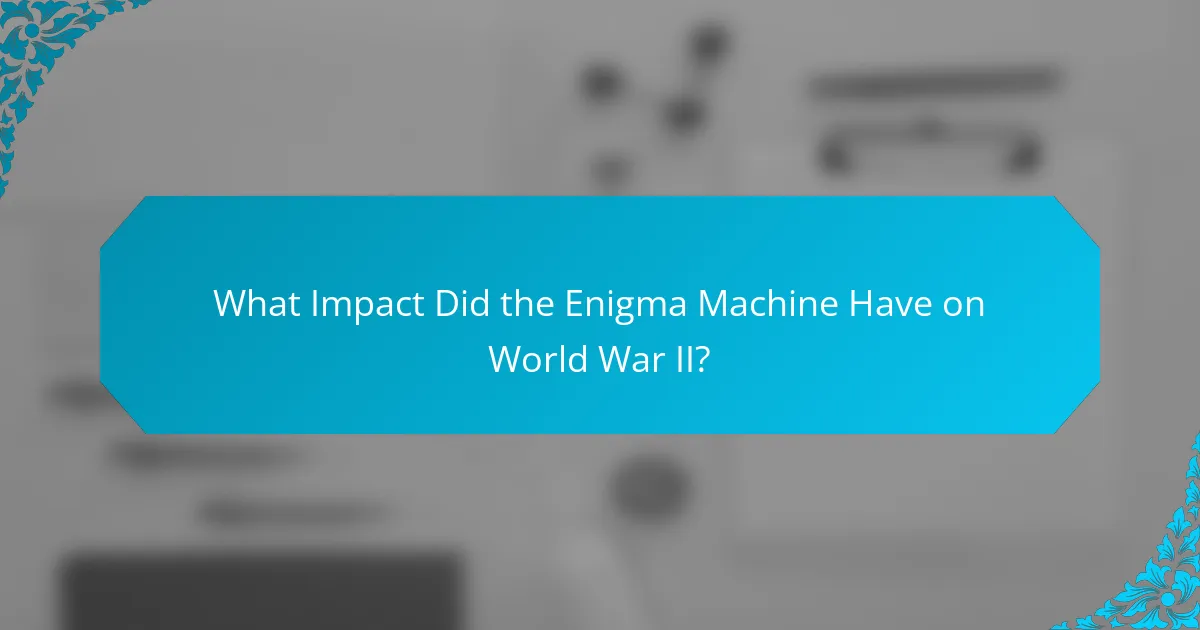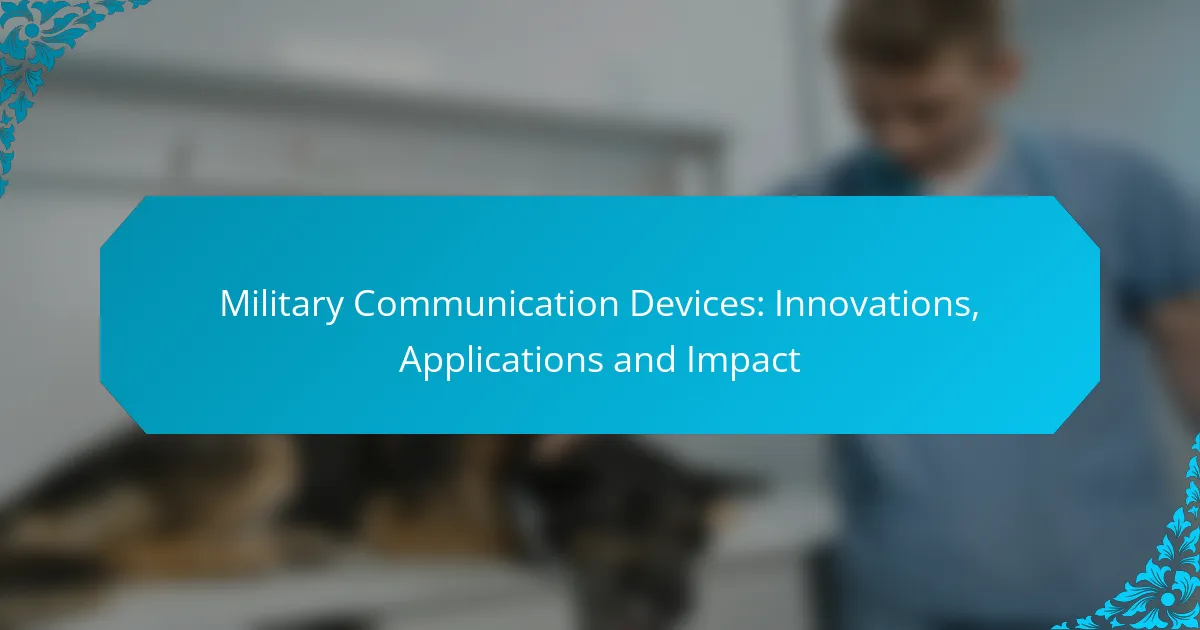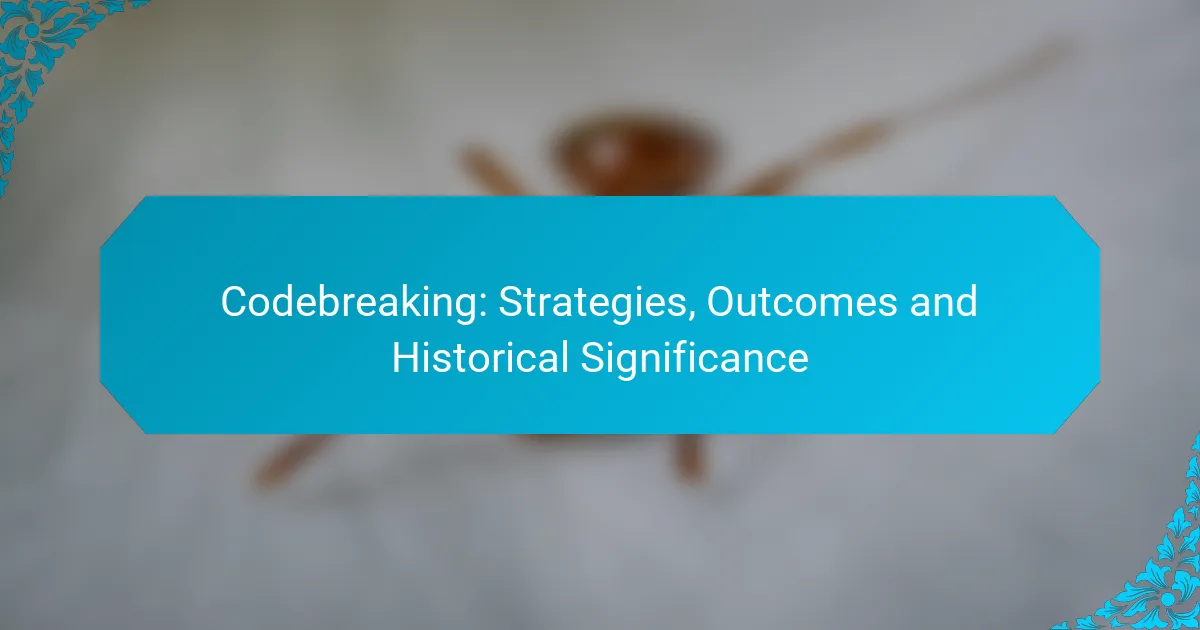The Enigma machine was a pivotal device for secure communication used by the German military during World War II, employing a sophisticated system of rotors to encrypt messages. Its intricate encryption methods not only provided the Axis powers with a significant advantage but also posed a formidable challenge to Allied intelligence efforts. The eventual decryption of Enigma codes, spearheaded by figures like Alan Turing, played a crucial role in shaping the outcome of the war and highlighted the importance of cryptography in modern warfare.

How Did the Enigma Machine Function in Warfare?
The Enigma machine was a crucial tool for secure communication in warfare, primarily used by the German military during World War II. It utilized a complex system of rotors and wiring to encrypt messages, making them nearly impossible to decipher without the correct settings.
Mechanism of encryption
The Enigma machine’s encryption mechanism relied on a series of rotating rotors that substituted letters based on their position. Each rotor had 26 positions corresponding to the letters of the alphabet, and as a key was pressed, the rotors would rotate, changing the letter substitution with each keystroke. This created a polyalphabetic cipher, significantly increasing the complexity of the encoded messages.
The machine also included a plugboard, which allowed for additional swapping of letters before and after the rotor encryption. This feature added another layer of security, making the encrypted messages even harder to crack.
Operational procedures
Operational procedures for using the Enigma machine involved strict protocols to ensure security. Operators were required to set the machine’s rotors and plugboard according to a daily key sheet, which specified the settings for that day. This practice meant that even if an enemy intercepted a message, they would need to know the exact settings to decode it.
Messages were typically short and concise, often limited to a few sentences to reduce the risk of errors during transmission. Operators also had to be trained to avoid common mistakes, such as reusing settings or failing to change them daily.
Key management
Key management was vital for the Enigma machine’s effectiveness in warfare. The daily key sheets were distributed securely to authorized personnel, and strict measures were in place to prevent unauthorized access. Any breach could lead to catastrophic consequences, as the enemy could gain insight into military plans.
To maintain security, it was essential to regularly change the key settings and ensure that all operators were aware of the current configurations. This constant updating helped to mitigate the risk of codebreaking efforts by adversaries, who were constantly attempting to decipher the Enigma’s messages.

What Impact Did the Enigma Machine Have on World War II?
The Enigma machine significantly influenced World War II by enabling secure communication for the Axis powers, particularly Germany. Its complex encryption methods posed a formidable challenge for Allied intelligence, impacting military strategies and operations throughout the conflict.
Intelligence advantages
The Enigma machine provided the German military with a robust means of encrypting messages, ensuring that critical information remained confidential. This encryption allowed for secure coordination of troop movements and strategic planning, giving Germany a considerable edge in early military engagements.
By using a series of rotors and plugboards, the Enigma could produce billions of possible settings, making it extremely difficult for adversaries to decipher intercepted communications. This complexity meant that even minor changes in settings could lead to entirely different outputs, complicating Allied efforts to break the code.
Allied countermeasures
The Allies recognized the threat posed by the Enigma machine and initiated extensive efforts to decrypt its messages. A pivotal moment came when British mathematician Alan Turing and his team at Bletchley Park developed techniques and machines, such as the Bombe, to automate the decryption process.
Through persistent analysis and collaboration with Polish intelligence, who had initially made significant breakthroughs, the Allies managed to read a substantial number of Enigma-encrypted messages. This intelligence allowed them to anticipate German movements and make informed strategic decisions, ultimately contributing to their victory.
Historical significance
The impact of the Enigma machine on World War II extends beyond military outcomes; it also marked a turning point in the field of cryptography and intelligence. The successful decryption efforts demonstrated the importance of codebreaking in modern warfare and led to advancements in computer science and information security.
Moreover, the lessons learned from the Enigma experience have influenced intelligence operations in subsequent conflicts. The legacy of the Enigma machine continues to be studied for its role in shaping the methods and technologies used in cryptography today.

How Was the Enigma Machine Decrypted?
The Enigma machine was decrypted primarily through the efforts of mathematicians and cryptanalysts, notably Alan Turing, who developed techniques to break its complex encryption. The combination of innovative methods and key breakthroughs allowed Allied forces to gain crucial intelligence during World War II.
Role of Alan Turing
Alan Turing played a pivotal role in decrypting the Enigma machine’s codes. He designed the Bombe, an electromechanical device that could rapidly test different combinations of settings to find the correct one used by the Germans. Turing’s work laid the foundation for modern computing and cryptography.
His analytical skills and logical reasoning enabled him to understand the underlying principles of the Enigma’s encryption. Turing’s contributions were not only technical but also strategic, as they significantly shortened the war and saved countless lives.
Techniques used
Several techniques were employed to decrypt the Enigma machine, including frequency analysis and pattern recognition. Cryptanalysts analyzed the ciphertext for recurring letters and common words, which helped identify potential settings of the machine.
Additionally, Turing and his team utilized the concept of “cribs,” which are known plaintext segments that could be matched against the encrypted text. This method allowed them to reduce the number of possible configurations significantly, making decryption more feasible.
Key breakthroughs
One of the key breakthroughs in decrypting the Enigma machine was the discovery of the “double letter” phenomenon, where certain letters in the plaintext would result in the same letter in the ciphertext. This insight provided critical clues about the machine’s wiring and settings.
Another significant advancement was the capture of Enigma machines and codebooks from German U-boats, which provided invaluable information about the operational procedures and settings used by the enemy. These breakthroughs collectively enhanced the Allies’ ability to intercept and decode German communications effectively.

What Are the Modern Applications of Enigma Machine Concepts?
Modern applications of Enigma machine concepts primarily revolve around cryptography and cybersecurity, where the principles of encryption and decryption are essential for secure communication. These concepts have evolved significantly, influencing current security protocols and practices.
Cryptography advancements
Advancements in cryptography have been heavily influenced by the principles behind the Enigma machine, particularly in the development of symmetric and asymmetric encryption algorithms. Modern encryption techniques, such as AES (Advanced Encryption Standard), utilize complex mathematical algorithms to secure data, similar to how the Enigma used rotor mechanisms to encode messages.
Additionally, the concept of key management has become crucial. Effective key generation and distribution methods ensure that only authorized parties can decrypt sensitive information. Organizations often implement practices such as regular key rotation and using longer key lengths to enhance security.
Cybersecurity practices
In cybersecurity, the lessons learned from the Enigma machine’s vulnerabilities inform current practices. For instance, the importance of robust encryption in protecting data against unauthorized access is paramount. Cybersecurity frameworks now emphasize the need for layered security measures, including firewalls, intrusion detection systems, and regular security audits.
Moreover, organizations are encouraged to adopt a proactive approach by conducting penetration testing and employing threat intelligence to identify potential vulnerabilities. Staying updated with the latest security patches and educating employees about phishing attacks are also critical steps in safeguarding against cyber threats.

What Are the Lessons Learned from the Enigma Machine’s Legacy?
The Enigma Machine’s legacy teaches critical lessons about the importance of secure communication in warfare and the ethical implications of using advanced technology for military advantage. Its ability to encrypt messages highlights the need for robust security measures, while its eventual decryption raises questions about morality in conflict.
Importance of secure communication
Secure communication is vital in warfare to protect sensitive information from enemy interception. The Enigma Machine exemplified this by using complex encryption techniques, making it difficult for adversaries to decipher messages. Modern military operations continue to rely on advanced encryption methods to safeguard communications, emphasizing the need for continual evolution in security practices.
Effective secure communication involves not only encryption but also proper training for personnel in handling sensitive information. Regular updates to encryption protocols and awareness of potential vulnerabilities are essential to maintaining security. For instance, adopting multi-factor authentication can significantly enhance the protection of communication channels.
Ethical considerations in warfare
The use of the Enigma Machine raises ethical questions regarding the balance between military advantage and the potential for civilian harm. As technology advances, the capacity for surveillance and data collection increases, necessitating a discussion on the moral implications of such capabilities in warfare. Ethical frameworks must guide the development and deployment of these technologies to prevent misuse.
Military leaders should consider the consequences of their actions, including the impact on non-combatants and the long-term effects of warfare. Establishing clear guidelines for the use of technology in conflict can help mitigate ethical dilemmas. Engaging in international dialogues about the rules of engagement and technology use is crucial for fostering accountability and transparency in military operations.

What Are the Future Trends in Cryptography Inspired by the Enigma Machine?
Future trends in cryptography, influenced by the Enigma Machine, focus on advanced techniques that enhance security and resilience against evolving threats. Innovations like quantum cryptography, artificial intelligence in encryption, and new security protocols are shaping the next generation of cryptographic methods.
Quantum cryptography
Quantum cryptography leverages the principles of quantum mechanics to create secure communication channels. Unlike traditional methods, it uses quantum bits (qubits) that can exist in multiple states, making it nearly impossible for an eavesdropper to intercept messages without detection. This technology is still in its early stages but shows promise for secure data transmission over long distances.
One of the most notable implementations is Quantum Key Distribution (QKD), which allows two parties to generate a shared, secret key. As quantum computing advances, the need for quantum cryptography will become increasingly critical to protect sensitive information.
AI in encryption
Artificial intelligence is transforming encryption by automating processes and enhancing security measures. AI algorithms can analyze vast amounts of data to identify vulnerabilities and adapt encryption methods in real-time. This proactive approach helps organizations stay ahead of potential threats.
For instance, machine learning models can detect unusual patterns in data access, triggering alerts for potential breaches. However, reliance on AI also introduces risks, as attackers may use similar technologies to exploit weaknesses in encryption systems.
Emerging security protocols
New security protocols are being developed to address the limitations of existing encryption methods. These protocols aim to provide stronger security while maintaining efficiency and usability. Examples include post-quantum cryptography, which is designed to be secure against quantum attacks, and multi-party computation, allowing parties to jointly compute a function without revealing their inputs.
Organizations should prioritize adopting these emerging protocols to future-proof their security infrastructure. Regularly updating encryption standards and conducting risk assessments will help mitigate potential vulnerabilities as technology evolves.



